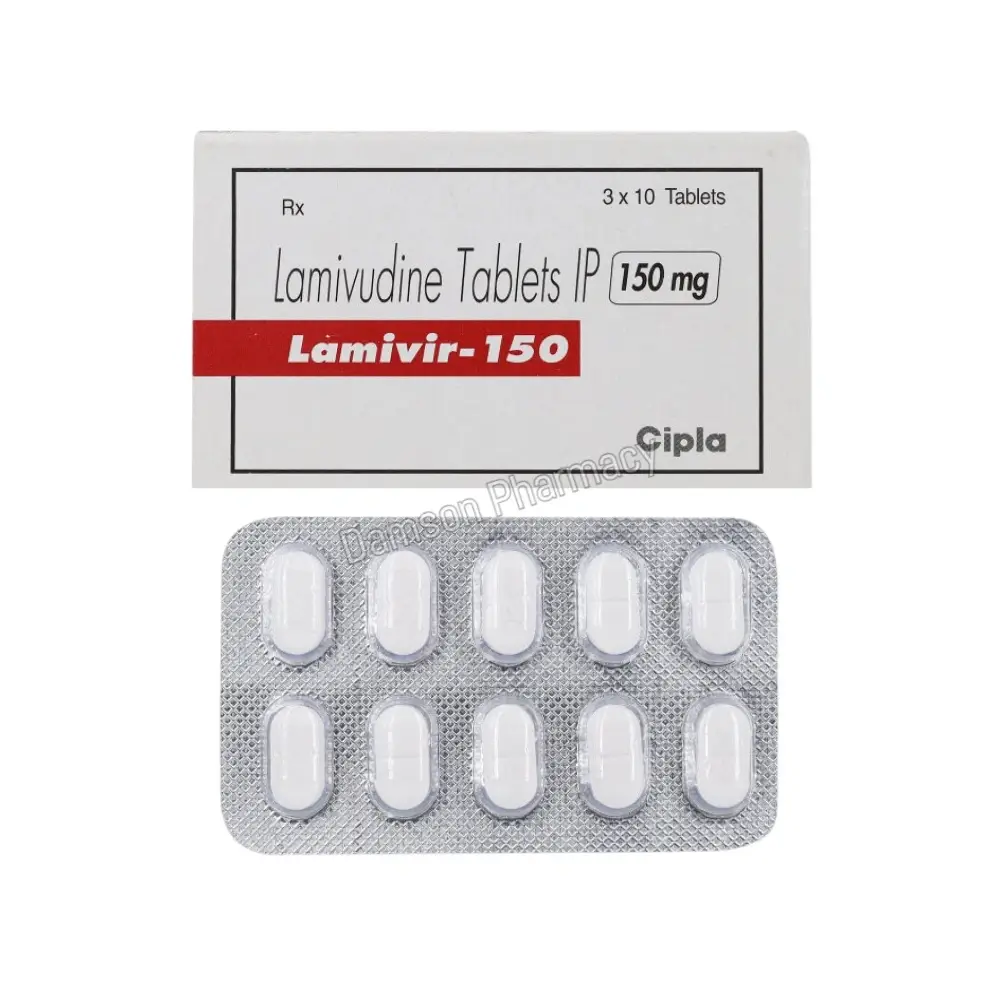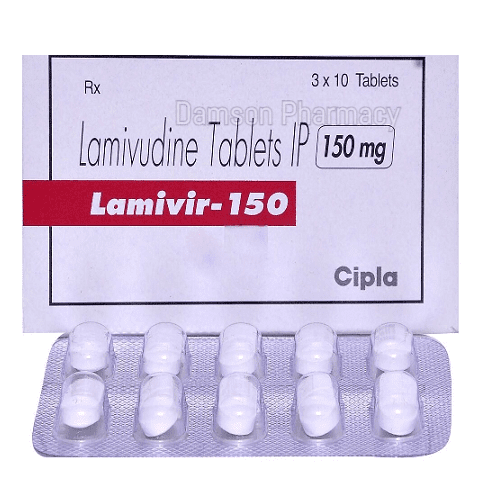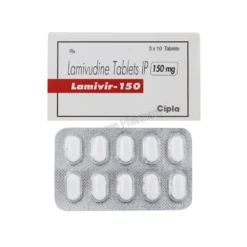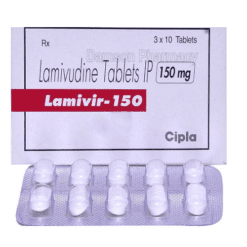Lamivir 150 Mg Tablets
$50.00 – $120.00Price range: $50.00 through $120.00
| Pack Size | Price | Price / Unit | Quantity | |
|---|---|---|---|---|
| 100 Tablets | $50.00 | $0.50/ unit | ||
| 200 Tablets | $90.00 | $0.45/ unit | ||
| 300 Tablets | $120.00 | $0.40/ unit |
Want to order in bulk / B2B price ? | Send Inquiry |


| SKU | 11368 |
| Manufacturer | Cipla Limited |
| Categories | Anti HIV |
| Delivery Time | 10 - 14 Working Days |
| Strength | 150mg |
Introduction to Lamivir 150mg Tablets
Lamivir 150 mg tablets contain the active ingredient lamivudine, which is an antiretroviral medication used in the treatment of HIV infection and chronic hepatitis B virus (HBV) infection. Lamivudine belongs to a class of drugs called nucleoside reverse transcriptase inhibitors (NRTIs).
Lamivir 150 mg Lamivudine Tablets as prescribed by a healthcare provider. Regular medical check-ups and monitoring are important to assess treatment effectiveness, manage potential side effects, and ensure overall health.
If you or someone you know is considering or using this medication, consult a healthcare professional for personalized advice and guidance based on individual medical history and needs.
Uses of Lamivir 150mg
Lamivir 150 mg Lamivudine tablets contain the active ingredient lamivudine, which is an antiretroviral medication used to treat several medical conditions, primarily related to viral infections. Here are the main uses of Lamivir 150 mg Lamivudine tablets:
- HIV-1 Infection Treatment
- Chronic Hepatitis B (HBV) Treatment
How Does Lamivir 150 Works?
Lamivir 150 contains Lamivudine, an antiretroviral medication that belongs to the class of nucleoside reverse transcriptase inhibitors (NRTIs). It is primarily used to treat HIV (Human Immunodeficiency Virus) and chronic hepatitis B infections.
Lamivir 150 works by inhibiting the reverse transcriptase enzyme, which the virus needs to multiply in the body. By blocking this enzyme, the medicine prevents the virus from replicating and lowers the amount of virus (viral load) in the blood.
Side Effects of Lamivir 150mg
Common Side Effects
- Nausea
- Headache
- Fatigue
- Diarrhea
- Abdominal Pain
- Insomnia
- Skin Rash
- Fever
- Muscle Pain
Serious Side Effects
- Severe Allergic Reaction
- Liver Problems
- Lactic Acidosis
- Pancreatitis
- Changes in Body Fat Distribution
- Blood Disorders
- Kidney Problems
Dosages of Lamivir
How To Manage Side Effects?
- Follow Prescribed Dosage and Instructions
- Regular Medical Check-Ups
- Stay Hydrated
- Take with Food
- Stay Hygienic and Moisturized
- Communicate with Your Healthcare Provider
- Adherence and Consistency
- Allergic Reactions
Warnings & Precautions
- Not A Cure For HIV: Lamivir helps manage HIV but does not completely eliminate the virus from the body.
- Take Exactly As Prescribed: Skipping doses or stopping suddenly may cause resistance and reduce treatment effectiveness.
- Monitor Liver Function Regularly: Lamivir may affect liver health, especially in patients with hepatitis B or C.
- Avoid Alcohol Consumption: Alcohol can increase the risk of liver damage during Lamivir treatment.
- Use With Caution In Kidney Disease: Dose adjustments may be needed in patients with impaired kidney function.
- Do Not Share Medication: Sharing Lamivir can be dangerous and spread resistant viral strains.
- Inform Doctor About Other Drugs: Lamivir may interact with other antivirals or medications affecting the liver or kidneys.
- Safe Sex Practices Are Essential: Even with treatment, HIV can still be transmitted—use condoms and follow safety guidelines.
- Pregnancy And Breastfeeding Considerations: Use only under medical advice during pregnancy or breastfeeding, as the drug may pass to the baby.
- Frequent Blood Tests Recommended: Regular lab monitoring is necessary to assess viral load, liver enzymes, and kidney function.
Storage
- Store at room temperature, ideally between 20°C to 25°C (68°F to 77°F).
- Keep away from moisture and direct sunlight to maintain the medicine’s stability and effectiveness.
- Do not freeze Lamivir tablets, and avoid storing in humid areas like bathrooms.
- Keep the bottle tightly closed when not in use to protect from air and contamination.
- Store out of reach of children and pets to prevent accidental ingestion.
- Do not use expired tablets—always check the expiration date printed on the packaging.
- Dispose of unused tablets properly, following local guidelines or pharmacy disposal recommendations.
Frequently Asked Questions
1. What Should I Do If I Miss A Dose Of Lamivir 150mg?
Ans. If you miss a dose of Lamivir 150mg, take it as soon as you remember. If it’s almost time for your next dose, skip the missed one. Never double the dose to make up for it.
2. How Should I Take Lamivir 150mg Tablets?
Ans. Take the tablets as prescribed by your healthcare provider. Follow the dosing schedule and instructions on the prescription label.
3. Can I Switch Or Stop Lamivir 150mg Without Consulting My Healthcare Provider?
Ans. Do not switch, stop, or alter the medication regimen without consulting your healthcare provider. Changes can impact treatment effectiveness and safety.
| Pack Size | 100 Tablets, 200 Tablets, 300 Tablets |
|---|---|
| Price/Unit | $0.40/unit, $0.45/unit, $0.50/unit |
Be the first to review “Lamivir 150 Mg Tablets” Cancel reply
Related Products
No related Products Found













Reviews
There are no reviews yet.